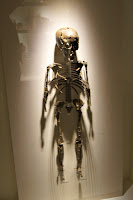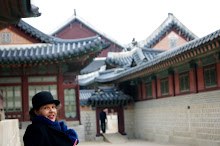This is "Reading the Letter" about the death of the poet Apollinaire - from Spanish Flu in 1918 - and I find it completely extraordinary that whoever wrote the Wikipedia piece in the link above doesn't know that. Pretty much all they say about it is "According to the Picasso Museum in Paris, the painting was discovered during the inventory of his studios after his death. It had previously been unknown. It was given as part of the estate to the French nation, which placed it in the care of the Picasso Museum."
So it was one of the paintings that Picasso never sold because it meant a lot to him. Apollinaire was very dear to him. I mean they even stole The Mona Lisa together, didn't they?
And I have to tell you that this painting's completely extraordinary up close. It looks like it's etched ... no, I'll tell you what it looks like. You know those silk paintings where you draw around the shapes you want with those raised inks and after it's dried you block in the colour inside so it doesn't bleed into the rest of the fabric? Well, it's done like that, but from the distance it all comes together so you don't notice.
That was the thing I noticed about most of the rest of the Picassos. They are magic from a distance and the further away you stand the better they look, however in close-up, standing where Picasso had to have stood to paint them, they are really quite crappy. Seriously! So how did he know whether or not the painting was working? He must have spent ages away from them and just staring.
BUT here's an inside scoop: something big happened to him in the early 1950s, because suddenly he's painting these exceptionally wonderful paintings when you're standing close, but they don't look like much when you're away from them. Most odd and quite possibly it was because he was needing glasses and wouldn't admit it.
This exhibition also had a few of the paintings from when he was a Mozart-like prodigious little boy, blowing away audiences with his fully developed talent before he was even into his teens. However they didn't have the ones from when he was about ten; paintings which I find really masterful but entirely creepy in their dire sentimentality. Like, how many ways can you paint dying children being wept over by distraught parents? You know, even if children can paint that well, they really shouldn't be allowed to choose their own subjects, should they!
As for the rest? Well, I found it kinda odd that there's those weird pointillist dots in the paintings right when his children would have been old enough to paint weird pointillist dots and if you go in close, you can see there's a different and more careful mind and hand putting them in. I think someone should ask his kids about this matter. Afterall, didn't Picasso complain his whole life about how his artist father used to make him paint "the boring bits" back when he was a winsy little kid? And aren't 'the abused' meant to go on and abuse in the exact same way?
And I can tell you for definite that after the 1970s, Picasso didn't care about art anymore and was definitely - 100% sure about this - only in it for the money. These later paintings are derivative, repetitive, trickster-ish and entirely crap. I'd even go so far as to say they show a deep hatred and contempt for whoeveritwas who would have purchased such complete rubbish.
Had to laugh about that because it was around this period that Aunty Irene bought her Picasso paintings (she also had lots of his pen-and-inks from his Minotaur period she'd bought earlier) (oh, and she also had that portrait of one of her many husbands done during Picasso's early Fauvist period which was rather special) which I always thought were unmitigated crap - although there is always something very special about famous paintings that you're permitted to take down off the wall and waltz around with, so you HAVE to love them - and I always guessed from her stories of visiting him at his studio that he truly detested her and everyone like her.
Tee hee! (If you knew her, you'd snigger too.)
What else? Oh, when Peter asked me what my favourite Picasso Period was, after thinking about it long and hard I decided it had to have been in the mid to late 50s when he (in my mind he'd finally got those glasses he needed and could see properly again) was playing with the imagery in The Great European Masters and subverting and deconstructing other Masters' masterpieces. Those were exceptional because they showed what was clearly a very clever mind at work and an artist at the top of his game. I especially loved the paintings where he shows he can exactly duplicate Rembrandt, say, right before he whizzes the style out into something completely different. Like, "See, I AM as good as you, you burke, and here's what I think of you." Much like Sir Edmund Hillary taking that contemptuous piss atop Mt Everest! Or, ooops, is that something we're not supposed to talk about!
And the very best bit of the day? That would have to be this: finally reaching the front of the 10,000 long queue only to find this ...
Galleries full. No more tickets issued that day!
... and instead of having to kill everyone around us, we simply flashed our Museum Passes and voila ...
Dah dah!
... immediately we're handed our free tickets. Gosh, those Museum Passes are wonderful things to possess! If you're living in HK, I can't encourage you enough to get your own.
And if you now want to see this exhibition, the details are HERE. And I do recommend you go because never before in my life have I ever been allowed to get in so close to really really look at how a painting was constructed - except Aunty Irene's ones and she wouldn't ever let you touch her good one - so this exhibition is worth seeing on those grounds alone.












